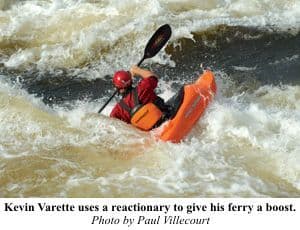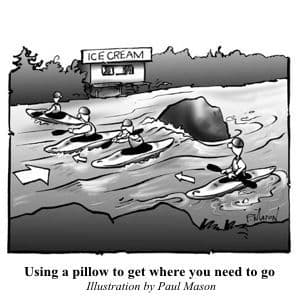Using the Power of the River
When I was learning, I was taught that kayaking was all about technique and that you didn't need to be powerful to do it well. Though there's a lot of truth to this statement, I can't pass on these words of wisdom without first clarifying something. Though good technique is integral to good paddling, there are times when it simply isn't enough to get you where you need to go. At these times, you may need to combine good technique with power, and this power will come from you and/or from the river. The focus of this segment is on how you can use the power of the river to your advantage.
 There are many ways to take advantage of the river's power, but we're going to focus on a few of the most common. We've already looked at a turning technique that uses the river's power in the "Turning Midstream" segment. In this segment we looked at how you can use the break on a breaking wave or hole to slow down one end of your boat while the other end continues downstream uninterrupted. This effectively spins you at the peak of a wave or side of a hole. Now, we're going to look at how to use waves and holes to help your ferries, and then we'll look at how you can use pillows to your advantage.
There are many ways to take advantage of the river's power, but we're going to focus on a few of the most common. We've already looked at a turning technique that uses the river's power in the "Turning Midstream" segment. In this segment we looked at how you can use the break on a breaking wave or hole to slow down one end of your boat while the other end continues downstream uninterrupted. This effectively spins you at the peak of a wave or side of a hole. Now, we're going to look at how to use waves and holes to help your ferries, and then we'll look at how you can use pillows to your advantage.

Waves and holes are the most common river features, and they can also be the most helpful to kayakers. Waves can give your ferry an added kick, and you a quick break. Consider a situation in which you are ferrying from one eddy to another. If there is a wave abutting the top of the initial eddy, exit so that your bow is in the trough of the wave and try to stay up on the face as you surf the wave across the current for a free ride. Be careful when exiting the eddy. If you pull into the current too far above the wave, you risk blowing through it as you come back downstream. If you enter the current downstream of the wave, you'll be pulling onto its backside and risk missing the wave and/or purling your bow underwater.
The backwash or foam pile of holes or pourovers can also be helpful for ferries. Although the aerated water may be quite turbulent, it can provide a great escape from the fast-moving main current. The trick is to stay on the foam pile without getting sucked right into the hole or falling off its backside, which of course takes practice. Each hole has a different backwash, and the real challenge is learning to read this kind of flow. Once you're comfortable, you can use the foam pile to ferry across the river. You can even use the recirculating water to give your ferry a big boost out the far side of the hole.

Pillows are features that can also come in handy. Remember that a pillow is formed as water piles up on itself after being backed up by a rock. You can use this slack water to slow your own downstream momentum and help make your ferry more effective.

A Final Note
As I mentioned in the beginning of this segment, there are many different ways of using the river's power to your advantage. A great way to learn how is by watching the best boaters as they make their way down rapids. They make things look easy by using every river feature to their advantage. Watch and see which eddies they catch, where they leave eddies, which waves they use to ferry, and how they get around or through holes. You should also take note of which strokes they use to do these things. I'm not necessarily suggesting that you copy the lines of better paddlers, but there's no doubt that you can learn a lot from watching them. Smart paddlers learn from their mistakes, but a smarter paddler learns from other people's mistakes.
Ken is a World Champion Kayaker and the author and producer of an award winning series of instructional kayaking books and videos. For more info, check out www.helipress.com